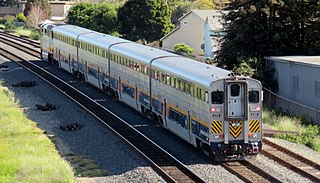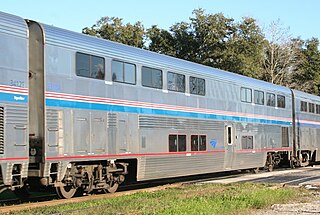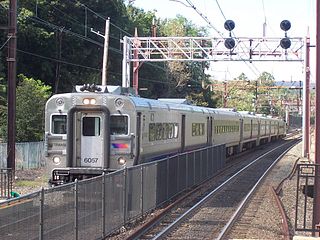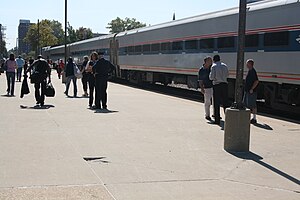
The Acela is Amtrak's flagship passenger train service along the Northeast Corridor (NEC) in the Northeastern United States between Washington, D.C., and Boston via 13 intermediate stops, including Baltimore, New York City and Philadelphia. Acela trains are the fastest in the Americas, reaching 150 miles per hour (240 km/h), but only over 49.9 miles (80.3 km) of the 457-mile (735 km) route.

The Maple Leaf is an international passenger train service operated by Amtrak and Via Rail between New York Penn Station in New York City and Union Station in Toronto via the Empire Corridor. Daily service is offered in both directions; the 544-mile (875 km) trip takes approximately 12 hours, including two hours for U.S. or Canadian customs and immigration inspection at either Niagara Falls, New York, or Niagara Falls, Ontario. Although the train uses Amtrak rolling stock exclusively, the train is operated by Via Rail crews while in Canada and by Amtrak crews in the United States. Service began in 1981.

A bilevel car or double-decker coach is a type of rail car that has two levels of passenger accommodation as opposed to one, increasing passenger capacity.

The San Joaquins is a passenger train service operated by Amtrak in California's San Joaquin Valley. Six daily round trips run between its southern terminus at Bakersfield and Stockton, with onward service to Sacramento and Oakland.

The Superliner is a type of bilevel intercity railroad passenger car used by Amtrak, the national rail passenger carrier in the United States. Amtrak commissioned the cars to replace older single-level cars on its long-distance trains in the Western United States. The design was based on the Budd Hi-Level cars used by the Santa Fe Railway on its El Capitan trains. Pullman-Standard built 284 cars, known as Superliner I, from 1975 to 1981; Bombardier Transportation built 195, known as Superliner II, from 1991 to 1996. The Superliner I cars were the last passenger cars built by Pullman.

A passenger railroad car or passenger car, also called a passenger carriage, passenger coach, or passenger bogie is a railroad car that is designed to carry passengers. The term passenger car can also be associated with a sleeping car, a baggage car, a dining car, railway post office and prisoner transport cars.

Amtrak California is a brand name used by the California Department of Transportation (Caltrans) Division of Rail for three state-supported Amtrak regional rail routes in California – the Capitol Corridor, the Pacific Surfliner, and the San Joaquins – and their associated connecting network of Amtrak Thruway transportation services.

Amfleet is a fleet of single-level intercity railroad passenger cars built by the Budd Company for American company Amtrak in the late 1970s and early 1980s. Budd based the Amfleet design on its earlier Metroliner electric multiple unit. An initial order for 57 cars in 1973 to supplement the Metroliners on the Northeast Corridor grew to two orders totaling 642 cars, sufficient to reequip all the services on the Northeast Corridor and many other routes around the United States. The first 492 cars, known as Amfleet I and completed between 1975 and 1977, were designed for short-distance service. A second order of 150 cars, known as Amfleet II and completed between 1980 and 1983, were designed for long-distance service. They were the last intercity passenger cars built by Budd.

The Comet railcar is a class of locomotive-hauled railcars that was first designed in the late 1960s by Pullman-Standard as a modern commuter car for North American rail lines. Later, the Comet moniker was adopted by NJ Transit for all of its non-powered single level commuter coaches. Additional series of cars bearing the Comet name, based on the original design, have since been built by Bombardier Transportation and Alstom. The successful design was adopted by numerous commuter agencies.

The Turboliners were a family of gas turbine trainsets built for Amtrak in the 1970s. They were among the first new equipment purchased by Amtrak to update its fleet with faster, more modern trains. The first batch, known as RTG, were built by the French firm ANF and entered service on multiple routes in the Midwestern United States in 1973. The new trains led to ridership increases wherever used, but the fixed consist that made up a Turboliner train proved a detriment as demand outstripped supply. The high cost of operating the trains led to their withdrawal from the Midwest in 1981.

The Wolverine is a higher-speed passenger train service operated by Amtrak as part of its Michigan Services. The 304-mile (489 km) line provides three daily round-trips between Chicago and Pontiac, Michigan, via Ann Arbor and Detroit. It carries a heritage train name descended from the New York Central.

The Pioneer III railcar was a short/medium-distance coach designed and built by the Budd Company in 1956 with an emphasis on weight savings. A single prototype was built, but declines in rail passenger traffic resulted in a lack of orders so Budd re-designed the concept as an electric multiple unit (m.u.). Six of the EMU coach design were purchased by the Pennsylvania Railroad with the intention of using them as a high-speed self-contained coach that could be used for long-distance commuter or short-distance intercity travel in the Northeast U.S. The 6 production Pioneer III units were the first all-stainless-steel-bodied EMU railcar built in North America and, at 90,000 pounds (41,000 kg), the lightest.

Shoreliners are a class of locomotive-hauled rail car used by the Metro-North Railroad. They are similar to the Comet coaches used by New Jersey Transit. Ownership of the fleet is split between the Metropolitan Transportation Authority (MTA) and the Connecticut Department of Transportation, as part of the latter's operating agreement with the MTA. MTA coaches have blue window bands, while CTDOT coaches have red ones. Many of the Shoreliner cars are named in honor of people and places significant to their service area, such as The Connecticut Yankee and Washington Irving.

The Jersey Arrow is a type of electric multiple unit (EMU) railcar developed for the Pennsylvania Railroad, and used through successive commuter operators in New Jersey, through to NJ Transit. Three models were built, but only the third model is in use today. The series is similar to SEPTA's Silverliner series, but include center doors among other differences in details.

The California Car is the first generation of intercity railcars owned by the California Department of Transportation (Caltrans) and operated by Amtrak under the Amtrak California brand on intercity corridor routes in Northern and Central California. The cars were built in the mid-1990s for the Caltrans Division of Rail by Morrison–Knudsen and the American Passenger Rail Car Company (Amerail). The cars are similar in exterior dimensions to Amtrak's Superliner, but original in design to provide rolling stock suitable for California intercity services up to six hours, with more frequent stops than most other Amtrak routes. All cars were overhauled by Alstom at its Mare Island facility between 2009 and 2012.

The Surfliner is a family of bi-level intercity railcars derived from the California Car. Like its predecessor, it is derived from the Superliner in design, and operated on Amtrak California's intercity routes in California. They are owned by both Amtrak and California Department of Transportation (Caltrans).

The Next Generation Bi-Level Passenger Rail Car was a failed design of bilevel intercity railroad passenger cars that was to be built by Sumitomo, with construction subcontracted to Nippon Sharyo. The contract was awarded in 2012 with delivery scheduled between 2015 and 2018. After delays in production, a prototype car failed buff strength testing in August 2015, leading to the cancellation of the contract with Nippon Sharyo. Siemens replaced Nippon Sharyo as the construction subcontractor in late 2017 and under the new contract, Siemens Venture railcars will be delivered between 2020 and 2023 instead of the bilevel design.

Siemens Venture is a type of locomotive-hauled passenger railroad car built by Siemens Mobility for the North American market. The cars are derived from the Siemens Viaggio Comfort cars used in Europe, with adaptations for North American operations. The cars entered service with Brightline in 2018 and with Amtrak Midwest in 2022. They have also been ordered by Amtrak for national and other state-supported routes, Via Rail, and Ontario Northland. The Venture cars will also be used on Amtrak’s Airo trainsets.

The first-generation Acela Express trainset is a unique set of vehicles used on the Acela, Amtrak's flagship high-speed service along the Northeast Corridor (NEC) in the Northeastern United States. When they debuted in 2000, the sets were the fastest in the Americas, reaching 150 mph (240 km/h) on 33.9 mi (54.6 km) of the route. They were built between 1998 and 2001 by a consortium of Alstom and Bombardier. Each set has two power cars derived from units that Alstom built for the TGV, and six passenger cars derived from the LRC that Bombardier built for Via Rail.






















